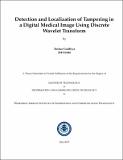Detection and localization of tampering in a digital medical image using discrete wavelet transform
Abstract
Use of digital images has increased tremendously in medical science as a diagnosis
tool. It made investigation easier and quick. But at the same time it raises the
question of authenticity of the image under scrutiny. Authenticity of the digital
image has been very important in the areas like scientific research, legal proceedings,
lifestyle publications, brand marketing, forensic investigations, government
documents etc. With the help of powerful and easy to use image editing software
like Microsoft Paint and Photoshop, it became extremely easy to tamper with a
digital image for malicious objective. Digital form of the image draws attention
of many researcher towards automatic diagnosis system for image analysis and
enhancement. These kinds of systems use harmless image manipulation operations
like brightness enhancement, gamma correction, contrast enhancement etc.
which improve quality of the image. It helps in better diagnosis. So it should not
be considered as a tampering. Likely and reported tampering of malicious intention
may be found in medical claims, health insurances or even legal battles in
which a medical problem may influence the judicial decision. Since use of digital
images in medical profession still is in nascent stage, we addressed the likelyto-
be-wrong-use of such input in this thesis. We propose an algorithm to enable
anybody to detect if or not a tampering is done with such malicious intention.
And if it is so, the almost precise localization of such tempering can also be done
successfully in a suspect digital medical image. The basis of our proposed algorithm
is the hash-based representation of a digital image. We use discrete wavelet
transform as a tool. It allows us to identify direction of tampering. The direction
of tampering helps us converge on the tampered object in the localization area. We
will show that our algorithm is robust against harmless manipulation, sensitive
enough for even a minute tampering. In case of multiple tampering, proposed
method is able to identify location as well as direction of multiple tampering,
while some of the existing methods fail in this area. Our proposed technique is
fast and generates smaller hash, as it works with smaller hash function in comparison
with the similar available techniques.
Collections
- M Tech Dissertations [923]

